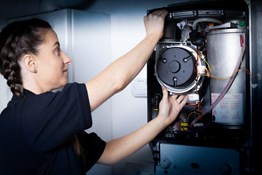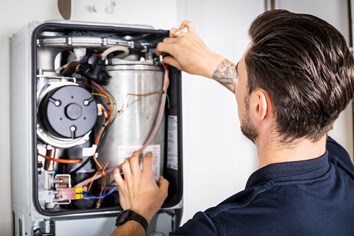Maintaining your boiler
15 February 2022
It's incredibly important to maintain your boiler to ensure that it doesn't break down when you need it most.
Below are some ways in which you can get the most out of your boiler for longer in turn, extending your boiler's lifespan and efficiency.
Checking your boiler
The first step to take would be checking your boiler’s vent connection and chimneys for any leaks. As with anything, your vent connection and chimney will deteriorate over time, so regular checks would become more essential as they get older. If you do see a problem with these parts, you can gauge whether there is going to be a problem with your system, but these parts are easier to replace and far more cost effective than replacing the whole boiler.

Heat exchanger
If you have found a leak in your boiler, but noticed it isn’t coming from your vent or chimney, there’s a very high chance its coming from your heat exchanger. This is the part of the boiler that exchanges the heat but isn’t meant to exchange any liquid. It’s important to replace your heat exchanger soon after noticing a leak before it grows larger and becomes more of an issue.
Flushing your boiler
Flushing your boiler is a key way of keeping your boiler fresh and operating at the optimum level and intensity. Over time, rust and debris can build up in your system, leading to lower efficiency, so flushing the boiler would clear all of this. More modern boilers can be left longer without flushing, but 5 to 6 years is the general guide of how often these flushes should take place.
This can be done in 4 stages:
- Turn off your boiler and let the water cool.
- Turn off your water supply valve and attach a garden hose leading to a bucket or a bathtub, ready for any drainage that comes from the system.
- Open the drain valve and air vents of the radiator, and let air into the pipes. Water from the system will then start flowing through the hose pipe, thus clearing any rust and debris. Wait until liquid completely stops flowing out.
- The system should now be clear. To refill the system, close the air vents and drain valve and turn on the water supply to the boiler. (If your boiler has an automatic shutoff, refilling is automatic.) If not, refill until the combination gauge reaches your boiler's ideal pressure level. In some cases, you may have to let air out of each convector of your system.
If you are unsure, please seek the help of a qualified, Gas Safe engineer for any assistance or boiler servicing. Swale heating have qualified engineers who can help this, please contact us here.
Lubricating the circulating pump
The circulating pump of a boiler heating system is responsible for moving all the water around the system. If the pump fails, effective home heating won’t be possible any longer. That’s why it’s vital to make sure that the pump continues to run and function properly. The best way to do that is by lubricating the circulating pump at least once a year. This can be accomplished by taking a 3-in-1 oil and pouring it into the oil cup of the system. The oil will penetrate down into the pump and help keep it from grinding and sticking as it operates.
Boiler service
Finally, one last way that you can maintain your boiler life is to have your boiler serviced by one of our experienced, Gas Safe registered engineers. Our engineers will be able to check over your boiler, and with a variety of different cover plans available to you, you will be able to ensure that your boiler's efficiency is maintained to the highest standard for as long as possible.
Swale Heating offer a range of boiler cover plans, which you can view here or give contact us here.
